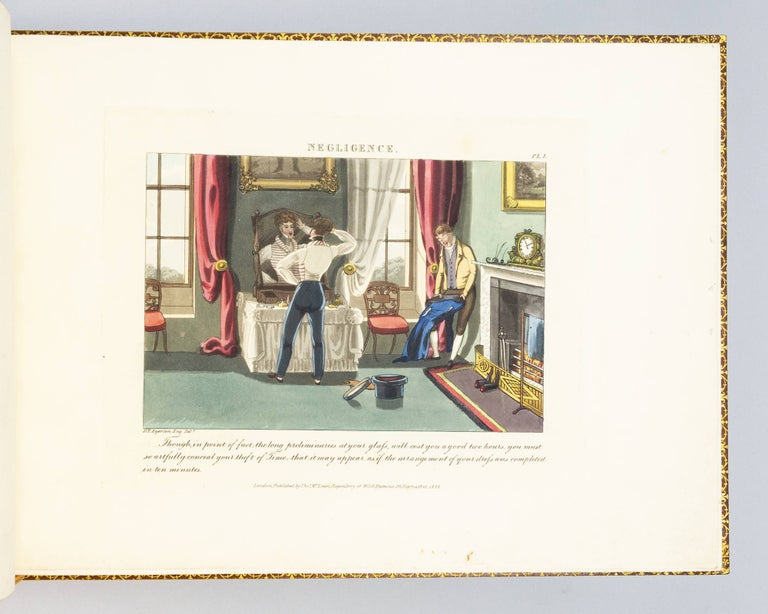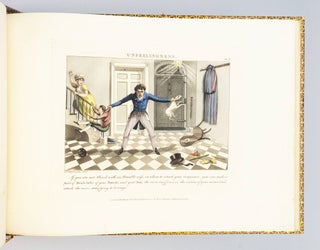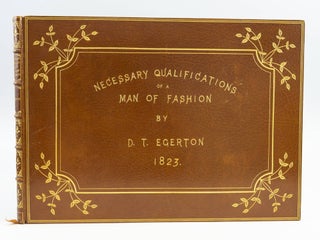NECESSARY QUALIFICATIONS OF A MAN OF FASHION.
(London: Thomas M'Lean, 1823). 270 x 370 mm. (10 1/2 x 14 1/2"). Title page, followed by plates. FIRST EDITION, with pre-publication watermarks.
FINE HONEY BROWN MOROCCO BY MORRELL (stamp-signed on front turn-in), covers with large frame of thick and thin gilt rules with sprays of leafy branches emanating from each corner, upper cover with gilt titling within the frame, raised bands, spine gilt in compartments with acorn centerpiece and leafy sprays at corners, gilt titling, turn-ins with ornate gilt roll, marbled yellow endpapers, top edge gilt. In a modern brown buckram slipcase. WITH 12 FINE HAND-COLORED PLATES by Egerton on paper with 1822 watermarks, all with guards. Front pastedown with bookplate of Maxine and Joel Spitz; verso of front free endpaper with book label of Thomas Kelly. Abbey, "Life" 286 (with 1824-25 watermarks); Tooley 204. ◆A touch of chafing (from slipcase?) to covers, just a hint of rubbing to joints and extremities (now scarcely noticeable after refurbishing), three small spots to title page, otherwise A VERY FINE COPY, the plates very clean and fresh with brilliant colors, and the binding lustrous, with few signs of wear.
This is a handsomely bound large-format series of amusing illustrations offering satirical advice to the would-be Man of Fashion, with watermarks (Whatman 1822) that indicate the plates here were among the first to be printed. The text and caricatures outline 12 essential traits for the man-about-town: Negligence, Assurance, Confidence, Impudence, Intemperance, Indifference, Unfeelingness, Forgetfulness, Selfishness, Intrigue, Eccentricity, and Inconsistency--in short, the exact opposite of the desirable traits in a gentleman. Ruthlessly mocking the obnoxious manners of a certain type of young swell, the artist encourages drunkenness ("become a four bottle man . . . a walking wine cellar"), gambling, forcing one's attentions on young ladies, and attempting to seduce the wives of one's friends, all while being rude, vicious, and without empathy.
Artist Daniel Thomas Egerton (1797-1842) was primarily known for his landscapes and illustrated travel books, and was an original member of the Society of British Artists. Egerton certainly knew something about cads and clearly possessed some of the "Qualifications" listed here, as he ran off to Mexico with the teenaged daughter of a fellow painter. The unfortunate couple was murdered in Mexico City, supposedly by a "robber," but one who neglected to take with him large amounts of money and jewelry.
The London bindery of W. T. Morrell was established about 1861 as successor to the firm begun by Francis Bedford, who, in turn, had taken over the famous bindery of Charles Lewis. Prideaux, in her "Modern Bookbindings" (1906), says that Morrell at that time had a very large business that supplied "all the booksellers with bindings designed by his men," bindings that were "remarkable for their variety and merit." This work continued for some years to be issued (with the 1823 date on the title), but it is not well represented in institutional holdings, and copies like ours with pre-publication watermarks are uncommonly seen. (ST15122)
Price: $8,500.00



